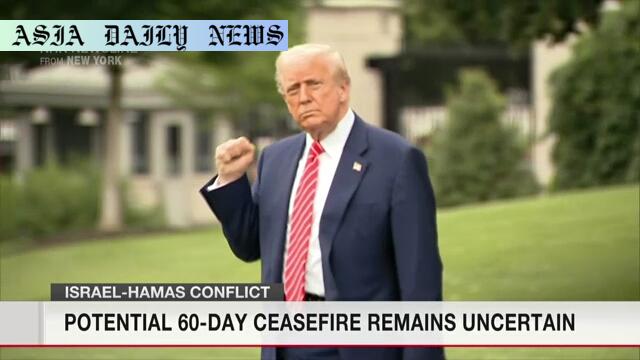Ceasefire discussions spark hope as Trump urges Hamas to agree to terms, while Gaza continues to face devastating attacks.

Ceasefire Proposal: A Ray of Hope amid Unrest
The situation in Gaza remains tense and precarious as calls for a 60-day ceasefire dominate international discussions. US President Donald Trump has taken to social media to urge Hamas and Israel to come to an agreement that could bring much-needed relief to the region. According to Trump, Israel has already accepted the terms for the ceasefire, though specific details of this agreement have not been publicly released. Meanwhile, Hamas has expressed its willingness to negotiate under certain conditions, citing the need for an end to aggression, an Israeli withdrawal, and urgent humanitarian aid to address the ongoing crisis.
The need for agreement on a ceasefire is underscored by the escalating violence in the region. Intensive Israeli airstrikes have claimed the lives of 142 individuals in the last 24 hours, according to local health authorities. The human toll of the conflict continues to grow, placing immense pressure on global leaders and mediators to reach a solution that can halt the bloodshed and restore a sense of normalcy to the lives of those in Gaza. The potential ceasefire offers a glimmer of hope for the people in Gaza, but significant political hurdles persist.
Hamas’ Conditions and the Challenges Ahead
The primary obstacle to the proposed ceasefire lies in Hamas’ unwavering stance. While the group has shown willingness to engage in dialogue, it remains steadfast in its demand for a complete cessation of hostilities, an Israeli withdrawal, and urgent delivery of humanitarian relief. These demands paint a complex picture of the road ahead, as they highlight not just the immediate needs of civilians but also the deep-seated grievances at the heart of the Gaza conflict.
One key component of the US-backed proposal involves the phased release of hostages held by Hamas in exchange for the ceasefire. This approach seeks to create a step-by-step reduction of tensions, but it also risks falling apart if either side perceives an imbalance in concessions. Furthermore, humanitarian agencies and local authorities stress the importance of immediate aid deliveries, which could help alleviate the despair among Gaza’s population and pave the way for long-term stability.
Global Reactions and the Path to Resolution
International reactions to the ceasefire proposal have been mixed. While some leaders hail the initiative as a necessary step for peace in the region, others remain skeptical about the feasibility of such an agreement, given the history of deep mistrust between the involved parties. Observers note that sustained efforts by mediators will be required to “bridge the gap” in expectations, as underscored in a recent Hamas statement.
The continuation of violence in Gaza adds urgency to these discussions. In the face of unrelenting airstrikes, countless families are grappling with displacement, loss of loved ones, and dire shortages of essential supplies. The international community must consider both the immediate and long-term implications of their policies as they push for a resolution. A balanced approach that addresses security concerns while prioritizing humanitarian needs has the potential to move the ceasefire negotiations forward.
Conclusion: An Uncertain but Essential Effort
The proposal for a 60-day ceasefire in Gaza represents a critical, albeit uncertain, step toward resolving one of the most complex and enduring conflicts in the Middle East. While the road to agreement may be fraught with challenges, the enormity of the human cost—particularly over the last 24 hours—underscores the necessity of continued diplomatic efforts. Time is of the essence, and the international community must use every tool at its disposal to foster conditions for peace and stability in Gaza.
Commentary
Acknowledging Global Efforts for Peace
The ongoing discussions about a potential ceasefire in Gaza highlight the persistent efforts of global powers to address one of the most challenging conflicts in recent history. The involvement of the United States, particularly under President Donald Trump’s leadership, emphasizes the urgency and importance of finding a middle ground. However, one cannot ignore the complexities at play, especially when it comes to satisfying the demands of both Hamas and Israel while addressing the dire humanitarian crisis on the ground.
Challenges in Bridging the Divide
Hamas’ conditions for a ceasefire reflect its priorities and the grievances of the Gaza population. Its insistence on an end to aggression and territorial occupation, coupled with the provision of humanitarian relief, directly addresses the immediate and long-term challenges faced by Palestinian civilians. However, gaining Israeli cooperation on these terms, especially amid ongoing airstrikes and security concerns, is a daunting task. The phased release of hostages proposed by the United States further complicates the negotiations, as it introduces an additional layer of mistrust and potential pitfalls for both parties.
Beyond Violence: A Call for Humanitarian Action
As the world watches the unfolding events in Gaza, it is crucial to remember the human stories behind the statistics. The loss of 142 lives in a single day is a stark reminder of the human cost of this conflict. Beyond politics and military action, there is an urgent need for humanitarian aid—medical supplies, food, and clean water—to mitigate the suffering of Gaza’s residents. Any ceasefire agreement must prioritize the immediate relief of the civilian population while creating pathways for long-lasting peace.
Conclusion: A Delicate Path Ahead
While uncertainty looms over the proposed 60-day ceasefire, it is clear that diplomatic discussions are vital to fostering peace in the region. The challenges are immense, but so too is the cost of inaction. By addressing both security concerns and humanitarian needs, the international community can contribute to a future where such conflicts are not only resolved but prevented.


